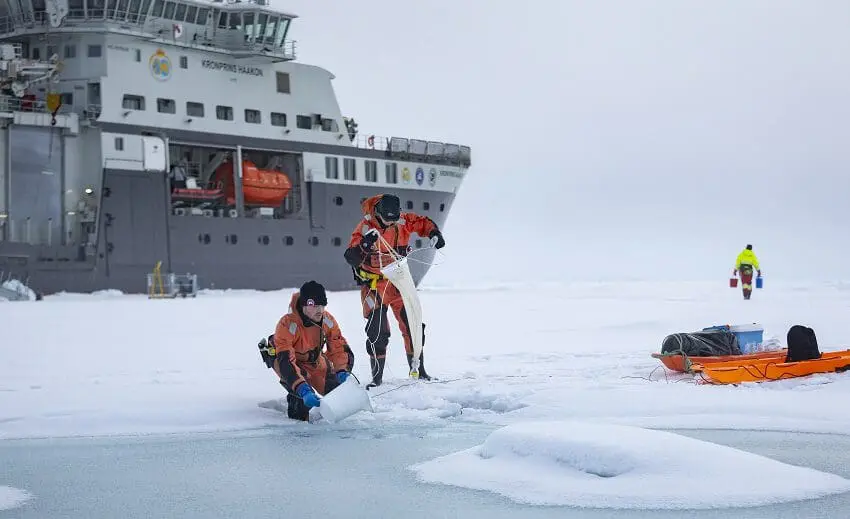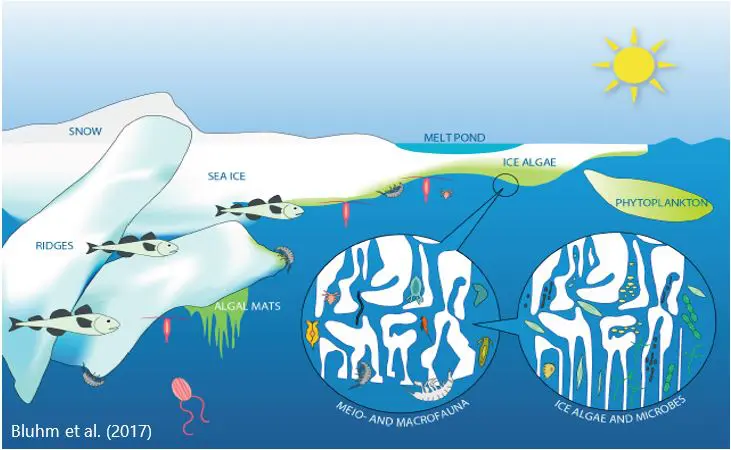Aliens in the Arctic? The outer-worldly life that resides within sea ice

Sampling microalgae in a melt water pond on top of the sea ice in the northern Barents Sea in August 2019
Top image: The research vessel “Kronprins Haakon” out on a cruise in the Barents Sea. Photo: Christian Morel
Sea ice. A characteristic feature of the Polar Regions. What do you picture when you think of sea ice? An extensive vastness of white, a few cute seals soaking up vitamin D, polar bears on the prowl? Would you believe that underneath their flippers and paws, is an ecosystem humming with life?
19 August 2021
Text: Vanessa Pitusi, UNIS and UiT
A community dominated by microscopic plants growing with the lowest levels of light and tiny invertebrates (> 0.02 mm) taking advantage of this all-you-can-eat buffet, in a labyrinth of small (< 1 mm) channels inside the sea ice (Figure 1). Just think of sea ice as an upside-down seafloor.
As small as these plants and animals may be, they are important players in the Arctic marine ecosystem; especially in the parts that are covered by sea ice all year around. Sea ice provides a feeding, breeding and nursery grounds for over 1,000 species of microscopic algae and a variety of invertebrates such as roundworms, wheel animals, and bristle worms. The highest number reported for these critters, in Arctic sea ice, was 400,000 ind per m2. Just visualise that – it is a lot of animals. Interestingly, the health of all larger Arctic animals, such as fish, birds and seals, can rely on the health state of this in-ice community. They may be small, but they are mighty.

Small, underwater monsters
But what are these invertebrates? What do they look like? The best way to describe them is alien-like. Creatures that have inspired Hollywood monsters, creatures that show an outer-worldly beauty hidden away out of plain sight, creatures that look like they should not be able to live yet they do. Let’s meet some of them!
Bristle worms, which are scientifically referred to as “polychaetes” are a highly diverse group of marine worms. They can be found in different shapes, colours and sizes all over the world. Even at the beach that you might got to, to swim and tan. Their diversity is what makes them so interesting. Perfectly adapted and shaped for the seafloor environment that they live in (usually within the seafloor), their larvae seek the small confines of sea ice in the Arctic. Safe from predators with an all-you-can-eat ice algae buffet at their disposal to grow and develop.
They transform from small babies into toddlers to teenagers in a matter of months before they outgrow their temporary home (Figure 2). During their maturation, they start growing a pair of feeding appendages called “palps”. Just imagine a worm with two pig tails on its head, much like Pippi Longstockings. These they will use once they have found a sandy home to catch food. Until now, only one species is known from sea ice – Scoleopsis squamata, which leaves much to be discovered.

Successful creatures
Let’s stay with worms and talk about roundworms, or as they are known to science as “nematodes”. This group of worms mostly resembles spaghettis or fibres, but do not be fooled by their rather simple body design. Their simplicity is what makes them not only beautiful, but also highly successful. They are one of the most abundant and diverse groups of invertebrates on the planet. Found in every environment – marine, freshwater, soil and parasitic, they have perfected adaptation.
Over the Arctic Ocean basins, they are endemic to sea ice completing their whole life cycle within it. It just is not practical to swim 3,000-m up and down just to reproduce and feed; easier to reside in sea ice all year around. Less energy spent “house-hunting” each year.
In Arctic fjords, sea ice acts as a feeding and breeding ground. Within the ice, they can find a mate, produce eggs (yes, they lay eggs much like chickens) from which larvae hatch (Figure 3). Much like the polychaete babies, they feed, feed, feed and grow. After the ice melts, they return to the seafloor, contributing towards the drawdown of carbon and aiding in decomposition processes (among other things). To this date, only four species have been described from Arctic sea ice and only one of those has been found in the seafloor. Yet again much more is left to discover about these seemingly simple invertebrates.

Changing climate affects sea ice
Sea ice has been changing the past forty years. Not only in extent and thickness, but also in type. The deep Arctic Ocean is characteristically covered by sea ice all year around. Formation of sea ice in Arctic fjords used to be reliable, but things are changing. Especially, in the Barents Sea which is one of the fastest warming regions in the Arctic, and the study site of the Nansen Legacy project. This means that sea ice ecosystems are in danger, but what kind of danger?
Is it the fact that the small animals from the seafloor and their larvae might lose their icy safe haven? Could the seafloor and water column become too crowded and food not plentiful enough if there is not any sea ice to retreat to? Could their development be impaired as food might become less available with more competition? These are questions that scientists will have to figure out and not just for the sea ice over the deep Arctic Ocean, but also the shallower shelf seas and fjord systems. There is a stark difference, and maybe near impossibility, between travelling 3,000-m rather than 200-m from the seafloor up to the ice for our sea ice seeking invertebrates.